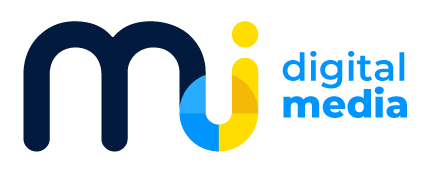This article originally appeared on the FOCUS blog.
Agile project management is a buzzword in the modern working world: easy to say but less than simple to implement. However, if you’ve decided to “go agile”, you’re probably already keen to start managing your projects more flexibly and clearly than with waterfall project management methods. In this article, you’ll learn how to apply agile principles with MeisterTask and sustainably optimize workflows for your team.
You’ve done it. By deciding to “go agile” with your team, you’re following in the footsteps of millions of companies worldwide who benefit from this dynamic project management method. Agile means faster, more focused workflows that improve collaboration within your team. Most importantly, by “going agile”, you’ll gain the ability to react quickly to changing customer requirements and remain competitive in your chosen market.
Actually recognizing the need for agile methodology in your team is a vital step towards a more efficient future for your projects. Now the question becomes more complicated: how will the principles of agile development work in practice? While the switch to agile can be complicated, a streamlined, intuitive tool can take a huge weight off your shoulders: MeisterTask.
Go Agile with Kanban
Any switch to agile project management should include the visualization of work processes, which enables rapid response to feedback and makes it possible to identify bottlenecks or delays at an early stage. Kanban boards offer an excellent way to achieve this visualization, which is why they are popular with software developers and project teams in a multitude of different industries. With this in mind, we’ve made Kanban-style boards the center of project management with MeisterTask.
Each project board you create in MeisterTask is endlessly customizable, which means you can tailor it to reflect your team’s workflow precisely. These boards are particularly well-suited for sprints — a bundle of tasks within a larger project that should be completed within a clearly-defined timeframe. With MeisterTask, you can create sprints either within a project, or as a separate project entirely.
In the most simple case, your sprint would be a small project split into columns that represent the planned passage from conception to completion. Something along the lines of “Planned”, “In Progress” and “Done” would work just fine. At the beginning of the sprint, all tasks would appear in the first column and be moved from left to right to subsequent columns depending on their progress.
At any time during the sprint, project team members can get a good overview of progress, which in turn means that potential delays can be handled in good time. You can even create automations that move completed tasks back onto the main project board, or use bulk actions to do this at the end.
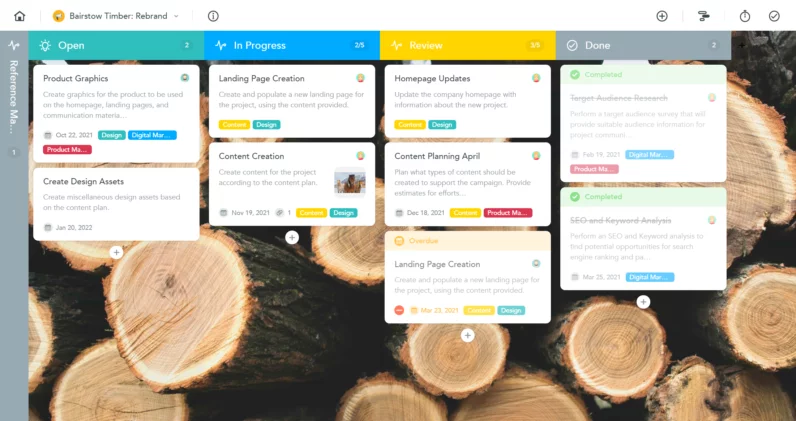
To recap, here’s how MeisterTask’s Kanban boards can support agile project management:
- Flexible, customizable workflows. Set unlimited project sections and customize them to best suit your workflow.
- Extensive collaboration. Invite team members and external collaborators to projects to keep you updated.
- Efficient delegation. Work is delegated quickly and easily by assigning tasks to team members.
Timeline: Everything at a Glance.
While Kanban boards are a great starting point for visualizing project workload, there is a slight limitation to their effectiveness — namely that each task on the board appears equal at a first glance. Often, project managers need more detailed insight into how long individual tasks will take to complete, which in turn helps them to meet deadlines and to satisfy customers (two core values of agile work.)
Our elegant solution to this problem: Timeline. This excellent MeisterTask Business feature shows “scheduled” project tasks with the help of Gantt-style charts. The “bars” on the chart indicate the start and end date of each task, while the task owner and the current task section (the color of the bar corresponds to the color of the column) are also indicated. With the help of this additional information, project managers can see which tasks are being worked on and when they will be completed. In other words, it is the perfect addition to your existing Kanban display.
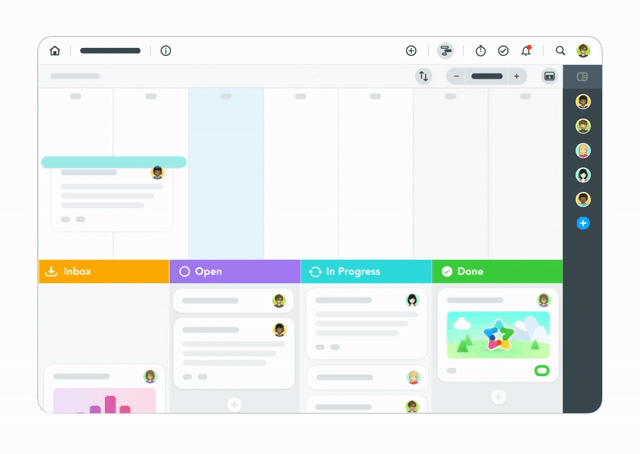
Thanks to the colored bars and avatars of the team members, project managers can easily keep an overview. In addition, task management with timelines has the great advantage that important relationships within a project appear clearly. You can see when priorities have to be distributed differently and when bottlenecks occur in the schedule.
Overload? Use WIP Limits
No project can be handled efficiently if tasks are backing up at and causing blockages for other team members. We’ve already looked at the value of sprints in helping divide workload into manageable packages. However, the ability to set clear limits to the number of tasks your project team can work will help you keep your processes lean.
Many agile coaches recommend WIP limits (work-in-progress limits), which is why we’ve included this handy feature in MeisterTask. You can use WIP limits to define the maximum tasks that can be included in each project section, thus ensuring your team is not overloaded by an unrealistic workload and can focus on the tasks that matter most. If a WIP limit is exceeded, MeisterTask indicates this with a warning triangle in the section header: a sign to tell the project manager that schedules or resources require adjustment.
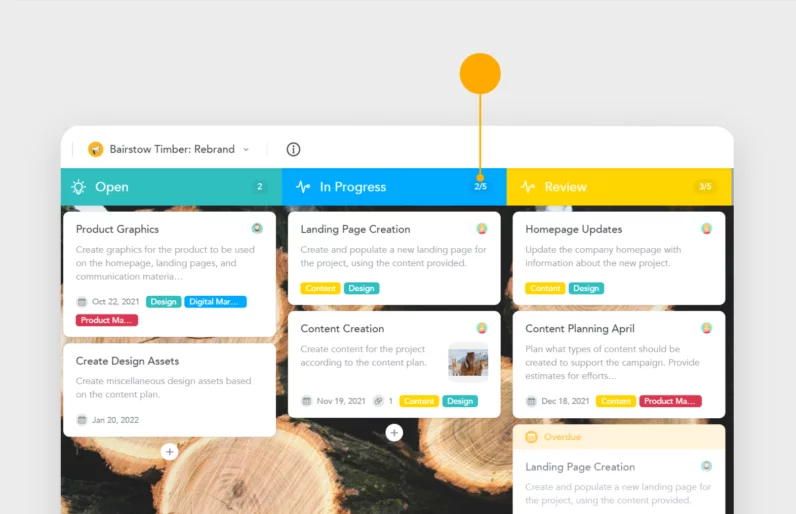
Need for Speed? Try Automations!
Actually following the principles of Agile development is a key step in improving your efficiency. By living the values of fast, customer-focused development, your team becomes more agile as a result. The original Manifesto for Agile Software Development states the need to prioritize working products over comprehensive documentation — and when you’re working to produce deliverables as quickly as possible, every shortcut counts.
This is where automations make their big appearance in MeisterTask. With these predefined actions, you can customize your boards to take the click-work out of your processes. For example, you can:
- Automatically assign tasks or move them to a specific column.
- Automatically complete tasks that are moved to the “done” column.
- Move tasks between projects/sprints when they are moved to a new section.
- Track time.
- Create recurring tasks that are due weekly or monthly.
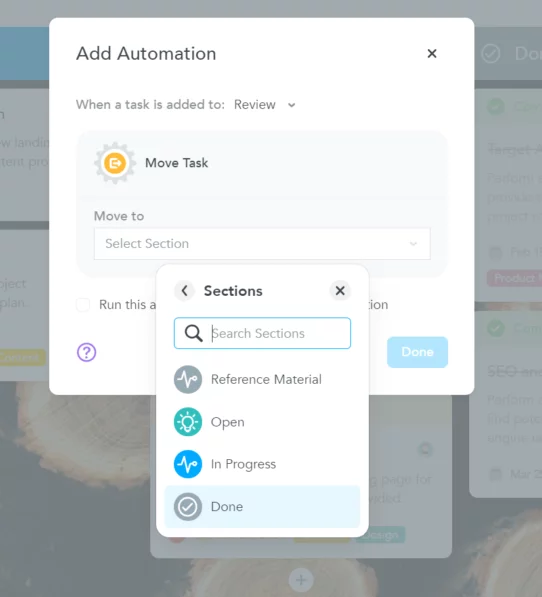
Still need more? If the native automations in MeisterTask don’t quite fit your specifications, you can also use Zapier automations, called Zaps, to connect thousands of apps with MeisterTask.
Look Who’s Talking…
Once again, MeisterTask is at your side to support you with “going agile” according to the Agile Manifesto. We’ve developed an intricate system of roles and permissions, which help you manage who is authorized to perform specific actions in your project, easing collaboration and integrating customers into the process. This is particularly helpful when collaborating with external partners, but also for keeping certain projects confidential from other teams in your company. You can invite users to a project and assign them the following roles:
- Administrator. Administrators have full control over the project. They can modify tasks, users and change all project properties (sections, automations, integrations, etc.).
- Member. Members can modify tasks in the project (create, edit, assign, complete, archive, trash etc.) but cannot change any project properties.
- Commenter. Commenters can view projects and comment on tasks but otherwise not modify them in any way. When a commenter comments on a task, they are automatically added as a watcher and are subsequently notified of changes made to the task.
- Read-only. Individuals with read-only permissions can open the project and view all tasks individually, but they can not edit the project or its tasks in any way.
When it comes to staying up to date, notifications are your best friends: they’ll keep you informed of changes, comments, mentions, etc. in a task. Task notifications are displayed in chronological order on the right side of your dashboard. You can also enable email notifications if you wish.
Make Agile Work for You

Now it’s time to take the leap. Switch to MeisterTask and see for yourself how we can help you implement agile principles in your team: wherever you are, whatever you do. Even if you’re not (yet) an expert in agile project management, MeisterTask is the ideal partner for your transition.
Our sleek, secure tool is packed with functions that automatically make your workflows more transparent and efficient. In no time at all, your team will be more productive and primed for a more modern, customer-centric way of work. If you’re managing a team, you’ll have enough to think about as it is. Let MeisterTask take a load off your mind.
This article originally appeared on the FOCUS blog.
